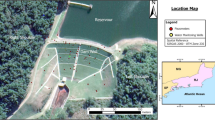Abstract
The roof and floor of a water-rich area can be explored using traditional two-dimensional (2D) electrical resistivity tomography (ERT), but this method cannot be applied to a water-rich internal working face. In this paper, the resistivity of an internal working face was determined using 2D ERT by laying electrodes and cables in two adjacent roadways and using an equatorial dipole device. The water inrush process of the goaf floor in the study area was monitored with pre-implanted electrodes and cables at the front of the mining working face and was analyzed using the processed results of four acquired data sets. The location of the water inrush from the floor was determined based on the change in the resistivity of the floor and the hydrological variations at the observational hole, which provided the basis for how to stop the water inrush.
Zusammenfassung
Wassergesättigte Bereiche im Liegenden und Hangenden können im Bergbau methodisch durch die klassische zweidimensionale Elektrische-Widerstands-Tomographie (2D-ERT) untersucht werden. Jedoch sind diese Methoden bei wasserreichen aktiven Ortsbrustbereichen nicht anwendbar gewesen. In dieser Untersuchung wird der Widerstand eines internen Ortsbrustbereiches durch die 2D-ERT-Methode beobachtet, indem die Elektronen und Kabel in äquatorialer Dipolausrichtung entlang von zwei Fahrwegen verlegt wurden. Der Wassereintrittsprozess am Versatzboden wurde im Untersuchungsgebiet mit Elektroden und Kabeln, welche vor der aufgefahrenen Ortsbrust eingebaut wurden, beobachtet und durch fünf aufgezeichneten Datenreihen analysiert. Zur Bestimmung der Lokation von Liegendwassereinbrüchen wurden die Widerstandsänderungen im Liegenden mit den hydrologischen Schwankungen aus einem Beobachtungsrohr verglichen. Dies bildet die Basis zur Verhinderung von Wassereintritten.
Resumen
El piso y el techo de un área rica en agua puede ser explorada utilizando una tomografía de resistividad eléctrica (ERT) bidimensional (2D), pero este método no puede ser aplicado a una cara interna de trabajo rica en agua. En este trabajo, la resistividad de una cara de trabajo interna fue determinada utilizando ERT 2D por electrodos y claves tendidos en dos vías adjacentes y usando un equipo de dipolo ecuatorial. El proceso de irrupción de agua desde la obstrucción en el piso en el área de estudio se monitoreó con electrodos y cables pre-implantados en el frente de la cara de trabajo minero y se analizaron los resultados de los 5 juegos de datos adquiridos. La localización de la irrupción de agua desde el piso fue determinada basándose en el cambio en la resistividad del piso y de las variaciones hidrológicas en el agujero de observación, lo que prove una base para conocer como detener la irrupción de agua.
摘要
传统二维电阻率层析成像技术可以探查煤层顶板和底板富水区,但该方法难用于回采工作面内部富水性探查。本文通过在工作面相邻巷道内预埋电极和电缆, 采用赤道偶极装置, 实现工作面内部二维电阻率层析成像探查。工作面采前预埋入电极和电缆方式,分析了四次数据成果,监测了采空区底板突水过程。于底板岩层电阻率的变化及观测孔涌水量的变化, 确定了底板突水点位置, 为封堵底板突水点提供依据。







Similar content being viewed by others
References
Cao Y (2008) The imaging technology of concurrent DC method. MSc thesis, Anhui University of Science and Technology, Huainan
Chavez RE (2015) Imaging fractures beneath a residential complex using novel 3D electrical resistivity arrays. J Environ Eng Geophys 20(3):219–233
Han DP, Zhang TM, Shi YD (1997) The principle and interpretation of the monopolar dipole DC penetration at working face. Coal Geol Explor 25(5):32–35
Liu SD, Wu RX, Zhang PS (2009) 3-dimensional parallel electric surveying and its applications water disaster exploration in coal mines. J Chin Coal Soc 34(7):927–932
Liu B, Li SC, Nie LC (2012) Research on simulation of mine water inrush real-time monitoring of using electrical resistivity constrained inversion imaging method. J Chin Coal Soc 37(10):1722–1731
Loke MH (2004) Tutorial: 2-D and 3-D electrical imaging surveys. http://www.geotomosoft.com. Accessed 11 July 2007
Loke MH, Barker RD (1995) Least squares deconvolution of apparent resistivity pseudosections. Geophysics 60(6):1682–1690
Shi LQ, Zhai PH, Wei JC (2009) Application of 3D high density electrical technique in detecting the water enrichment of strata. J Shandong Univ Sci Technol 27(6):1–4
Tejero-Andrade A, Cifuentes G, Chávez RE, López-González AE, Delgado-Solórzano C (2015) L- and corner-arrays for 3D electric resistivity tomography: an alternative for geophysical surveys in urban zones. Near Surf Geophys 13(4):355–367
Wu RX, Liu SD, Zhang PS (2010) The exploration of two gateways parallel 3D electrical technology for water-rich area within coal face floor. J Chin Coal Soc 35(3):454–457
Yue JH, Li ZD (1999) Effect of direct current prospecting in mine roadway. J Chin Coal Soc 24(1):7–10
Yutaka S (1994) 3D Resistivity inversion using the finite-element method. Geophysics 59(12):1839–1848
Acknowledgements
The work of the first author was supported by the National Science Foundation (41572244), the Shandong Province Nature Science Fund (ZR2015DM013), and special funds provided by the Taishan Scholars construction projects and the Shandong University of Science and Technology graduate innovation science and technology fund (SDKDYC170212). The authors gratefully acknowledge the anonymous reviewers that substantially improved the manuscript.
Author information
Authors and Affiliations
Corresponding author
Rights and permissions
About this article
Cite this article
Gao, W., Shi, L., Han, J. et al. Dynamic Monitoring of Water in a Working Face Floor Using 2D Electrical Resistivity Tomography (ERT). Mine Water Environ 37, 423–430 (2018). https://doi.org/10.1007/s10230-017-0483-z
Received:
Accepted:
Published:
Issue Date:
DOI: https://doi.org/10.1007/s10230-017-0483-z




